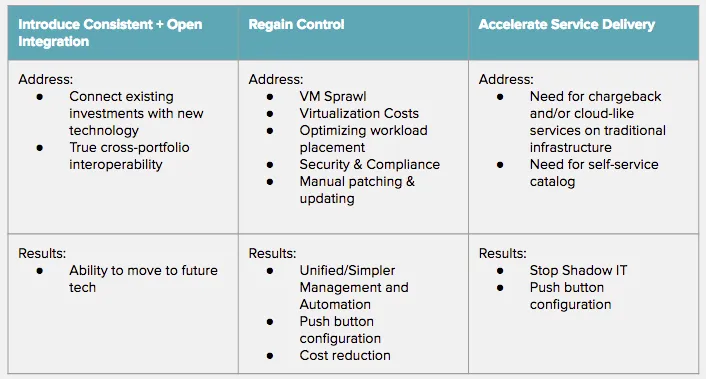Virtualization remains, and, I believe, will remain, an integral part of the modern datacenter for the next several years. According to the Uptime Institute, up to 65 percent of workloads are still on premise. And while virtualized workloads may give way to the cloud, it still puts virtualization in specific focus as a technology piece that needs to be modernized. Modern virtualization can provide a means to innovate, streamline, and optimize the infrastructure. Modernizing your virtualization can help to pull you out of the following negative cycle:

A lack of automation and standardization frequently contributes to issues with patching and security, while shadow IT often arises from a lack of services or a poor rate of service. Additionally, the complexity of the environment coupled with the previous issues can lead to “survival mode.” “Survival mode can then feed back into inability to innovate and the negative cycle can begin anew.
To help break out of this circle, it’s not so much a case of “more tools” as it is “different tools.” More specifically, modern tools.
For example, simply deploying a virtualization platform on its own can only solve a few problems.Deploying a virtualization platform that can integrate more easily with management, automation and other tools and investments, however, helps to solve broader problems and can provide a path to modern virtualization. Such is the case with Red Hat Virtualization, Red Hat CloudForms and Ansible, respectively.
To be perfectly clear, much of this modernization can include migrating from another virtualization platform to Red Hat Virtualization. I’d like to highlight three primary areas that can specifically address modernizing virtualization and how this can help you to realize the listed results:

-
Introduce more consistent and open integration - This is really about introducing Red Hat Virtualization to the environment. It’s built on Red Hat Enterprise Linux, Kernel-based Virtual Machine (KVM) and JBoss - all open source technologies. While many administrators will utilize the web-based UI, others will automate the platform using the REST API and/or Ansible integration. This is designed to provide cross-portfolio interoperability as well as the ability to integrate with existing investments.
-
Regain control - This involves deploying Red Hat CloudForms and taking advantage of its integration with Red Hat Virtualization. In the context of virtualization, CloudForms allows us to directly address issues like virtual machine (VM) sprawl, workload optimization, and provide policy based security and compliance remediation. The ability to address the first two items can have a positive effect on the bottom line. Ansible also provides an easier means of automating the configuration of the virtual environment as well as patching. All of this together can help IT organizations regain control of the operation and the budget.
-
Accelerate service delivery - By utilizing the chargeback features of Red Hat CloudForms, you can provide cost features or accountability. This helps to create self-service portals for more consistent end user experiences while also providing configurations that are approved by security and compliance. Adding Red Hat Satellite to this mix can also help to manage the software lifecycle for Red Hat Enterprise Linux VMs and the Red Hat Virtualization hypervisors.
These are all steps that provide a “Path to Modern Virtualization” in order to help integrate, control, and accelerate. A means to help step out of the negative cycle of “Can’t Innovate”, “Outside Resources”, and “Just Surviving”.
Interested in learning more?
-
Read a Red Hat-sponsored IDC whitepaper about virtualization and Red Hat Virtualization specifically
-
For the more technically minded, see the previous webinar on Red Hat Virtualization & Ansible Integration
-
For the more business minded, see the previous webinar series on Modern Infrastructure
Sobre os autores
Red Hat is the world’s leading provider of enterprise open source software solutions, using a community-powered approach to deliver reliable and high-performing Linux, hybrid cloud, container, and Kubernetes technologies.
Red Hat helps customers integrate new and existing IT applications, develop cloud-native applications, standardize on our industry-leading operating system, and automate, secure, and manage complex environments. Award-winning support, training, and consulting services make Red Hat a trusted adviser to the Fortune 500. As a strategic partner to cloud providers, system integrators, application vendors, customers, and open source communities, Red Hat can help organizations prepare for the digital future.
Mais como este
Red Hat OpenShift Virtualization: The strategic platform for virtualization customers
Red Hat OpenShift Virtualization 4.20: Hybrid cloud-flexibility and enhanced VM management
Aligning With Open Source Principles | Code Comments
Edge computing covered and diced | Technically Speaking
Navegue por canal
Automação
Últimas novidades em automação de TI para empresas de tecnologia, equipes e ambientes
Inteligência artificial
Descubra as atualizações nas plataformas que proporcionam aos clientes executar suas cargas de trabalho de IA em qualquer ambiente
Nuvem híbrida aberta
Veja como construímos um futuro mais flexível com a nuvem híbrida
Segurança
Veja as últimas novidades sobre como reduzimos riscos em ambientes e tecnologias
Edge computing
Saiba quais são as atualizações nas plataformas que simplificam as operações na borda
Infraestrutura
Saiba o que há de mais recente na plataforma Linux empresarial líder mundial
Aplicações
Conheça nossas soluções desenvolvidas para ajudar você a superar os desafios mais complexos de aplicações
Virtualização
O futuro da virtualização empresarial para suas cargas de trabalho on-premise ou na nuvem

